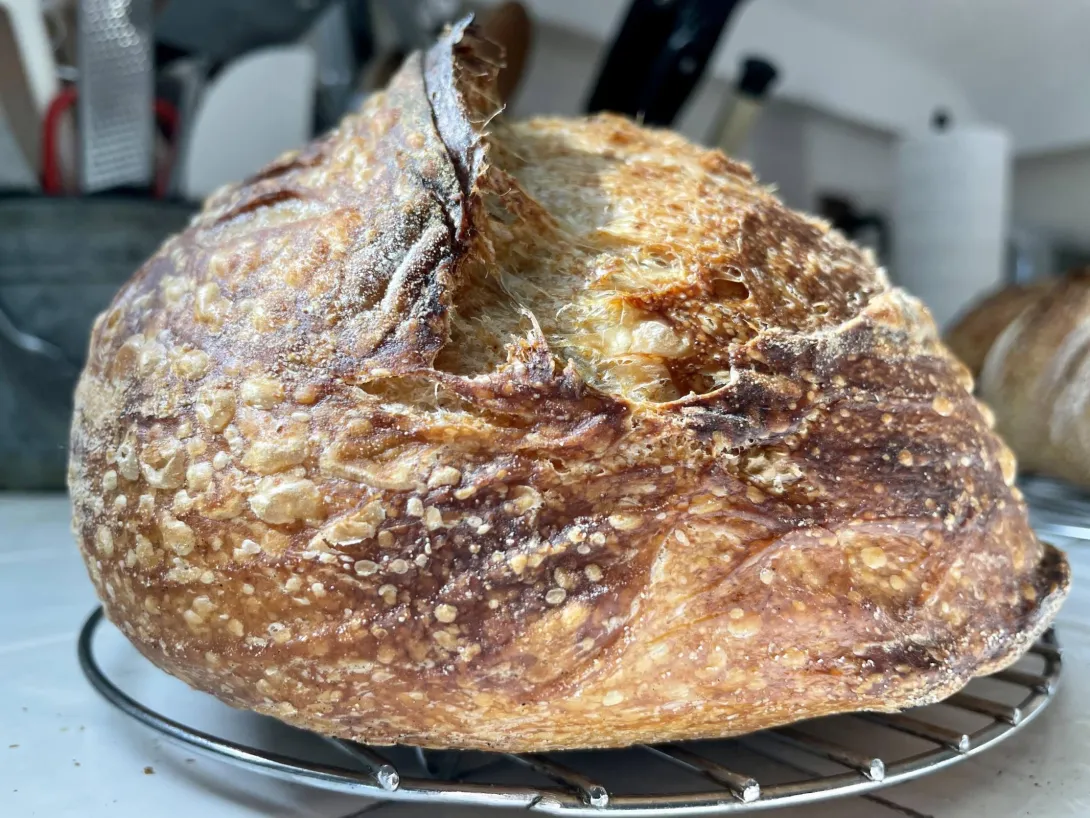
Hi bakexperts--
I've been stumped by loave's flat bottom edge--that part where the curved side comes down and meets the bottom. Ideally it's nice and round, even curving underneath before meeting the flat bottom surface. But sometimes that edge curves down to an abrupt angle with the bottom, with no rounded edge to it. Somtimes I see this in loaves baked from the same batch of dough and even in the same bake. But today I saw it in a single loaf itself! Half had a rounded edge and half was angled in a dual personality. So the simple question is, what's going on? And the second question is, is there a name for this bottom edge?
Thanks!
Ansel
P.S. Baking details: Baked @ ~500 in dutch oven sprayed w/H20. Oven stone tiles on top and pizza steal below.
P.P.S. Here is a crumb shot from a different loaf (but same dough batch). The offending loaf was sold, despite its aberrations...

Ansel, is the area at the bottom flat side a result of a blow out?
Did the gluten tear or not seal there?
Or, possibly there was a large pocket of air in that area.
Hi Dan,
Thanks for taking a look. As to your theories: 1) I don't think it was a blowout, as there was plenty of moisture for expansion, and the scoring was effective judging by the prominent ear on top. 2) I didn't notice any skin tear, so I think it was sealed, 3) I didn't cut into this (as it's headed to a customer, assuming this aberration is acceptable!), so I can't comment on the interior. But when I have seen this angled edge characteristic before on loaves I did cut into, it hadn't been associated with an air pocket.
Ansel
I wonder if that part of the dough became stuck to the surface it was baked on as it was lower or slid onto that surface. Then the lateral force on that stuck part caused it to look pulled away from the main dough.
What do you bake on or in and how to do get the dough onto the surface or into the vessel for baking?
Hi Benito,
Thanks for your theory. I boke in cast iron pots, transferring the loaves in via parchment paper. I've had instances where the dough comes in contact with the sides of the hot pot which the dough instantly sticks to. But this doesn't impede the oven spring, which still occurs and if anything results in a flat edge (shaped by the side of the pot). So I don't think this would explain the severe taper in the loaf I've shown here in question.
lol. Got a picture of the bottom of the loaf?
Bread bottoms are the only porn allowed here! But I don't think that's really relevant to the question at hand, as it's not the bottom I'm concerned with but the side edge tapering to the bottom. It's a sharp edge (seen right side in pic) instead of being rounded (seen left side in pic).
That bread looks pretty good. Congrats!
The extra darkness on the top of the loaf compared to the sides hints that you used top heat, as in a convection oven or a toaster/pizza oven.
More heat from the top, even in a covered dutch oven, relative to the bottom, leads to bottom blow out.
My guess: You had a _partial_ bottom blow-out, just enough to bulge, but not enough to "erupt" through the crust.
Excess Lots of blistering suggests you sprayed a lot of water on the loaf, or used too many ice cubes. I'm guessing that some water pooled in that corner, just enough to weaken/soften the dough-skin/crust there, which allowed the deformation and bulge.
Another possibility is that it is some artifact of shaping. Maybe a bubble expanded and then collapsed right before the crust hardened.
--
As said by Mini, more pictures from different angles would have helped.
And a description of your oven and baking mode used would have been useful to a possible diagnosis. That's one thing people-asking-for-help seem to leave out the most. There's more than one type of oven, and more than mode of using them.
Dave,
First of all, thanks for the kind words! Aside from the aberration on the edge, the loaf came out nice (along with the 15 others that didn't have this issue).
Second of all, well done on your forensic analysis. You're correct in assessing that I sprayed water on the loaves before sealing them in the dutch oven. It's possible some water pooled as you speculated, causing the dough to weaken and result in the deformity. Your shaping/bubble theory is also possible, as the dough was quite active/bubbly I put it in the bannetons for the overnight cold proof.
Sorry I can't offer more pics as the loaf already went to market. But I did add baking details to the original post per your suggestion. As mentioned there, the oven (not convention) has stone tiles above the dutch ovens to deflect the heat from the element, and a pizza steel on the bottom rack to deflect heat from the bottom heating element. Not sure if this configuration leads to more heat on top as you describe. I guess it depends on the radiant heat properties of steel verses stone.